| |
|
|
WANDERING GLIDER
Pantala
flavescens
|
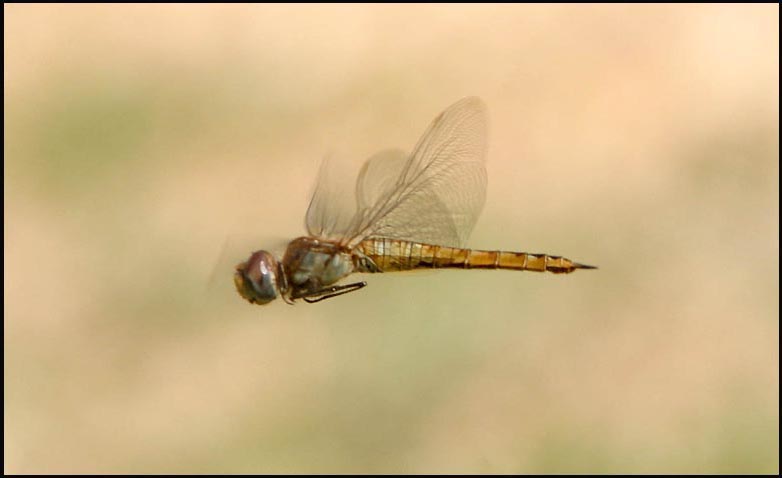
photo (above) 19
Sep 2006 Laguna Grande,
Seaside
|
|
Wandering Glider is almost always on the
wing. They fly high and
low, in swarms and alone, far and near. Hikers on a warm Indian Summer
day at Garrapata State Park may encounter hundreds riding the currents
at the edge of rocky gorges. The winds take them out across the ocean —
they've been seen by birders on pelagic trips far at sea, and they've
made
it to Hawaii. They are found throughout the world as the great wanderer
of the odonata realm. It seems fitting, then, that a flight shot should
serve as our headline photo.
When found perched (below), one sees an
intricately patterned ode hanging
vertically. The wings are clear. The eyes are brick-red, and the
pterostigma are golden. The thorax is a cheesy-yellow, marked down the
center with reddish
lines and ending in 2 or 3 dark blue blotches on the 8th through 10th
abdominal
segments.
photo (below) 7
July 2006 Carmel River mouth
|
|
|
When perched, Wandering Glider generally picks a
twig or weed near
the ground, and becomes very inconspicuous (below).
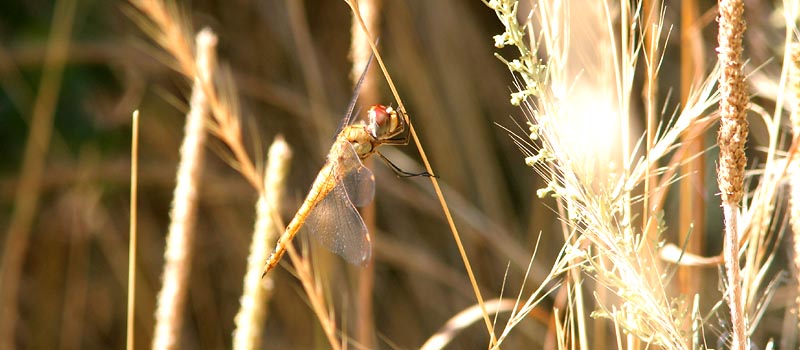 It is quite a matter of luck that the first two gliders I ever
encountered
happened to be flying over small territories at the Carmel River mouth,
and by standing still they both settled down into perches for these
photos
(above & below). This species is within a group known as "rainpool
gliders" because they deposit eggs in ephemeral pools. The larvae
quickly
develop and emerge before the pool dries up. Gliders that emerge in
northern
latitudes in the fall fly south to breed in spring (Manolis 2003).
It is quite a matter of luck that the first two gliders I ever
encountered
happened to be flying over small territories at the Carmel River mouth,
and by standing still they both settled down into perches for these
photos
(above & below). This species is within a group known as "rainpool
gliders" because they deposit eggs in ephemeral pools. The larvae
quickly
develop and emerge before the pool dries up. Gliders that emerge in
northern
latitudes in the fall fly south to breed in spring (Manolis 2003).
Photo (above) 7
July 2006 Carmel River mouth
|
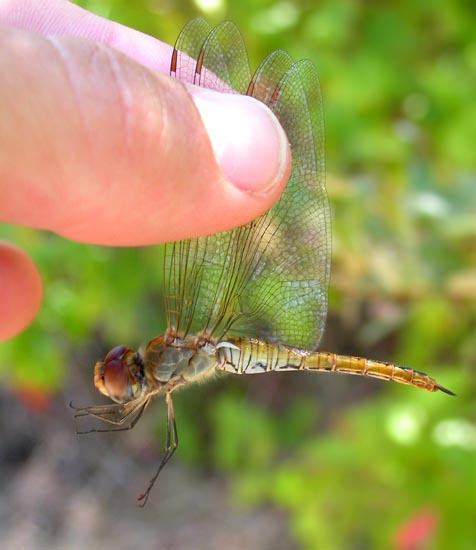 Male
and female Wandering Gliders are much alike. Both show simple flanges
as
appendages. Males tend to be brighter yellow in color. Male
and female Wandering Gliders are much alike. Both show simple flanges
as
appendages. Males tend to be brighter yellow in color.
There are some cool comments on behavior in Beaton
(2007): "Frequently
seen in parking lots, attempting to lay eggs on shiny car hoods."
And you wondered what those were. "Most often seen patrolling small
bodies
of water, from puddles to ditches. Flight includes frequent hovering
and
apparently effortless gliding, and consists primarily of slow
monotonous
patrols up one side and down the other of the puddle. . . Appears easy
to catch but is not."
Nonetheless, Rob Fowler and colleagues at Big Sur
Ornithology Lab netted
this one (right) at Big Sur R. mouth in July 2004, constituting the
first
confirmed record for MTY. It is actually a quite common species,
especially in fall, and can be found in large feeding swarms of other
Wandering
Gliders and, sometimes, with Spot-winged Gliders.
Photo (right) 14 July 2004 Big Sur
R. mouth [©Rob
Fowler]
|
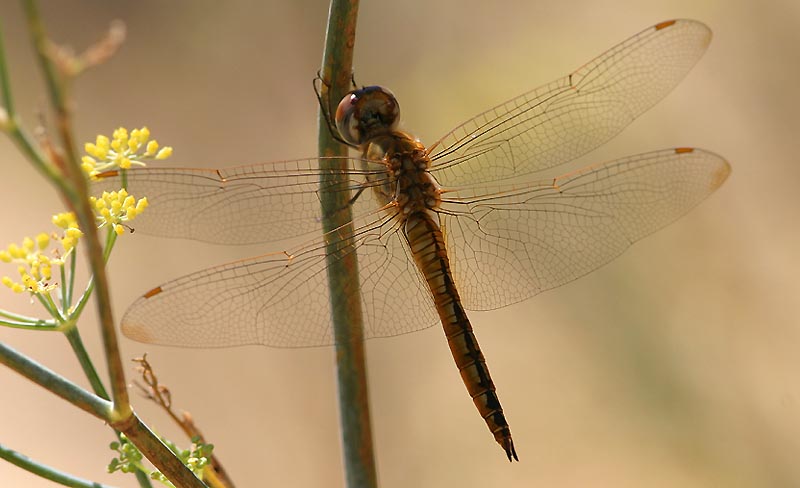
This close-up of a perched individual — taken in Sacramento — nicely
shows the very broad hindwings that make this ode such an effortless
glider.
The duller color to the body and the grayer eyes suggest this is a
female
or immature individual.
Photo (above) 12
Aug 2006 along American
River, Sacramento SAC
|
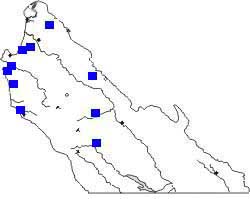 This
map shows some representative locales at which this glider has been
observed.
All are over open country — fields, coastal dunes, ag land, and lawns
in
city parks among them. The species has only been reported in MTY since
2004, so records are still accumulating. They could occur almost
anywhere.
A glider seen over the Pacific Ocean ~25 nmi W of Pt. Sur on 27 Aug
2006
was probably this species (Roger Wolfe). This
map shows some representative locales at which this glider has been
observed.
All are over open country — fields, coastal dunes, ag land, and lawns
in
city parks among them. The species has only been reported in MTY since
2004, so records are still accumulating. They could occur almost
anywhere.
A glider seen over the Pacific Ocean ~25 nmi W of Pt. Sur on 27 Aug
2006
was probably this species (Roger Wolfe).
MTY flight dates ranges from 22 May–27 Sep.
Elsewhere in California
they regular occur March to November, with a peak in the fall (Manolis
2003)
but there are recent records from Jan-Feb which (presumably) represent
very late individuals.
|
|
|
Literature cited:
- Manolis, T. 2003. Dragonflies and Damselflies of
California. Univ. of
Calif.
Press, Berkeley.
Web resources:
Major identification web sites with much information on California
odes include:
For sites with excellent photos to compare for identification or to
simply
enjoy, see:
Many of these sites have links to other useful pages. Kathy Biggs's
site
is particularly useful in her selection of links. |
|
All photos © Don Roberson 2007
TOP
|
|
|
Page created 24 Feb 2007,
updated 23 May 2007
|
|
|
|
|
